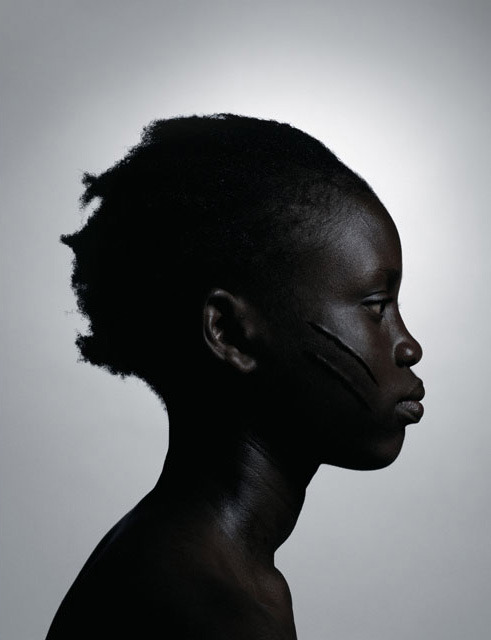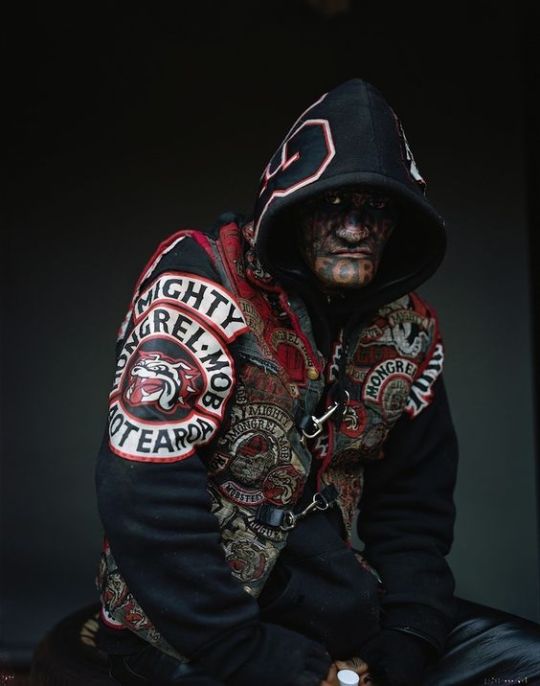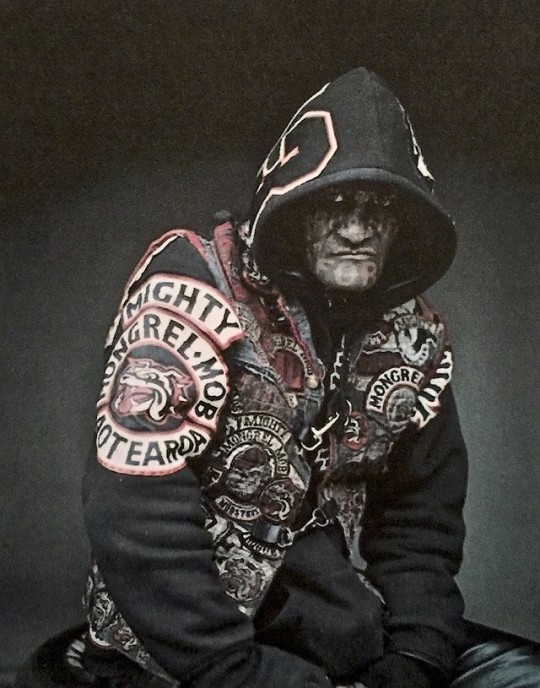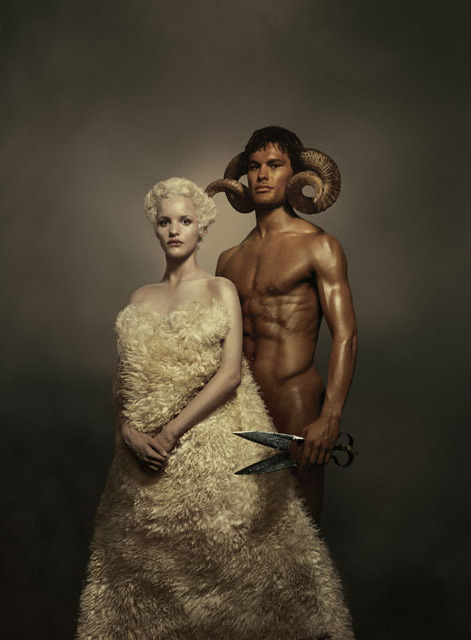#jono rotman
Text
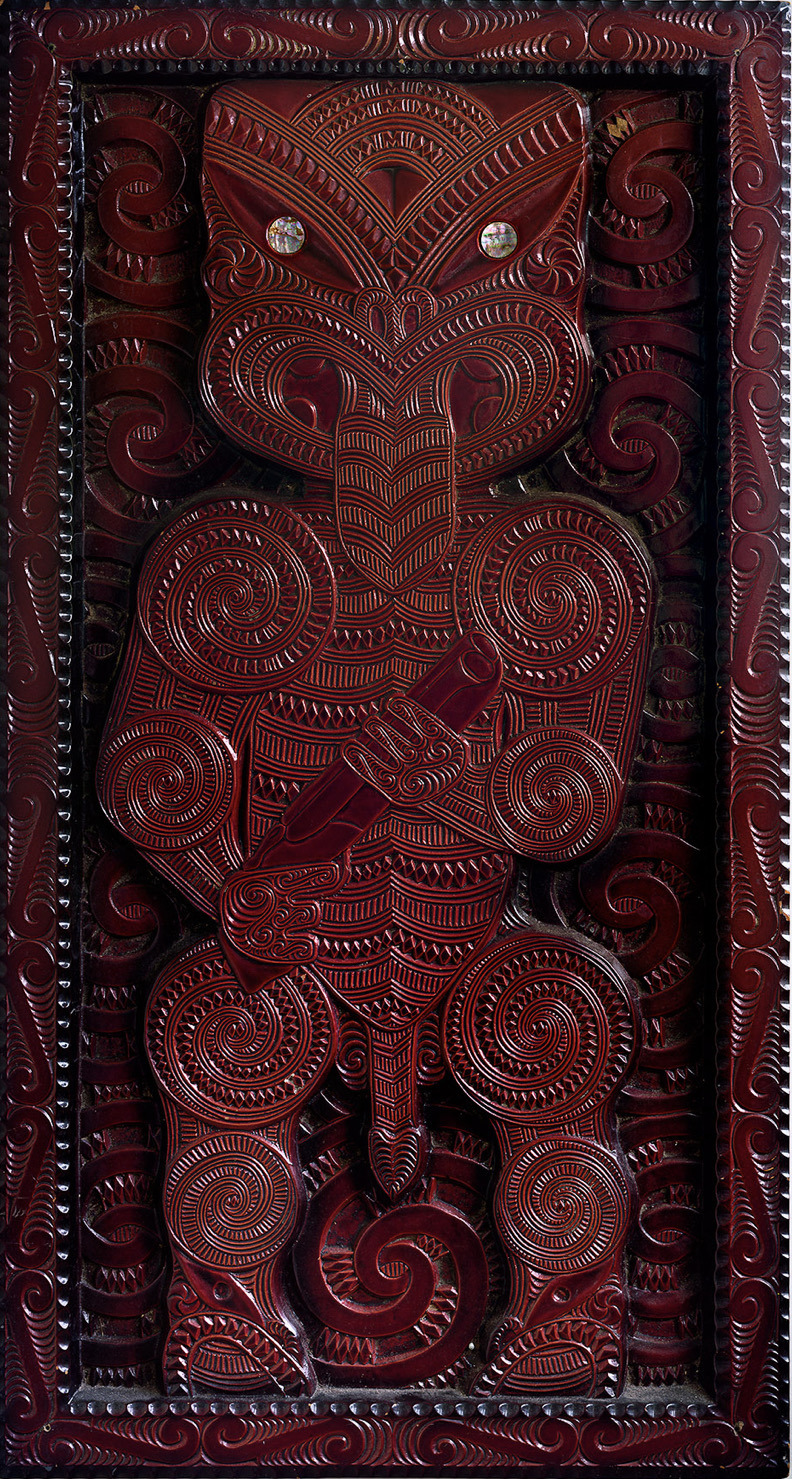
Jono Rotman, Little Man Rogue, President RIP, Red Hill, MMX|I, from the series Mongrelism
58 notes
·
View notes
Text
Reflection
I have always prided myself on being able to set a goal and stick to it no matter what. I realised that throughout my schooling I was very goal orientated. I would have very clear sight of what I wanted to achieve. Through my Design degree however, I have learnt and realised that these goalposts can be moved and in fact, it is sometimes best they are moved as then you reach an even higher goal.
Being in my third year now I have found that my end product is sometimes completely different than what I set out to achieve and this is what occurred with this photography project. The idea and key I find is to keep an open mind and always reflect back on research and ideas that may have not seemed important at the time.
One thing remained the same throughout this project and that was in my original brief where I focused on something that I am personally passionate about which is how young Māori and Pasifika students can struggle with identifying with their culture. I say personally because I feel I have just begun my cultural journey myself as I was born Ngapuhi but never really identified as Māori until starting at university. To be honest I didn’t feel I had the right to as my skin is so white. What I have learnt however is that I do have the right to identify with my culture as do all my subjects I photographed.
My pitch, therefore, remained the same as did my target audience. I decided however that I needed more than just an exhibition as I wanted the audience to be able to take home a keepsake so that the message will last longer than their memories of the images. It is also a way to reach others that are maybe not able to attend the exhibition.
This is how my publication whanaungatanga evolved. I did not want simply a book of pretty pictures however. I wanted the images to be etched into the minds of viewers and it was for this reason that I made the book interactive. I cut out the picture frames so the viewer can see the image behind them. This is to symbolise the layers involved with each subject's struggle. Having something different and unique is going to remain in the viewer's memory for longer.
Whanaungatanga as the name suggests is more than just a publication however, it is reflective of the close bond I formed with my subjects throughout this process. I developed this Kaupapa after hearing their stories of how they had struggled with identifying with their cultures. In order to make authentic portraits, you need to have a deeper understanding of the relationships between the photographer and the subjects and what camera conventions best give the desired final outcome. This changed my direction with photography and gave me the depth I needed.
This was key to the new direction I took with my images as before this I had planned to include movement to symbolise the more spiritual aspect of culture and each individual subject but after establishing the Kaupapa with each of my models, I found the movement I had initially included almost cheapened the raw emotions I was seeing in my photographs. I did not want to show the spiritual side of them representing maybe their ancestors, I wanted the viewer to see only them.
It was at this point I revisited all the research I had made and what stood out for me. This is when I looked at one of my earliest research pieces which was the work of Jono Rotman with his Mongrel Mob images. I initially had not agreed with this series as I fundamentally disagree with gangs and gang members and thought possibly it was glorifying gangs. What I liked most about this article and looking at the work of Rotman is that it challenged my views of portrait taking and made me want to consider more deeply my subject matter and how it can in turn challenge the viewer.
The concept of putting your subject up close and personal and in the spotlight almost is what I needed to do with my subjects, and this is why I moved away from the image movement concept to that of the inclusion of a blank photographic frame, As my research showed me, having a frame within a frame focuses the viewer and allows the raw emotion to shine through. In Māori and Pasifika cultures, family portraits or portraits, in general, hold great importance as it gives control over their own images. The significance of them holding the frame is that they are creating their own image by telling their story.
As with the images of Jono Rotman, my photographs were void of context beyond the lone subject. There is nowhere to hide, and the viewer is challenged to observe the information that is right in front of them.
I also revisited the work of Raymond Sagapolutele and in particular his Out of Context series where he shared the stories of Aotearoa born Pacific Islanders like himself. Sagapolutele felt an obligation to capture his subjects and their stories and how they see themselves. This is what I was feeling after hearing the stories of my subjects and incorporating movement and the notion of adding LED lights which was another direction I had considered previously, were just not cohesive with what my subjects were feeling and telling me. I needed to do their stories justice and let their feelings unfold before the viewer's eyes.
After all my reflection and changes in direction, I feel that I have done my subjects proud. I am telling their stories in their way and by having the exhibition partnered with my interactive publication, I can reach others similar to them who are struggling with identifying with their cultures and show them that each of us have our own journeys to follow and it does matter where they are on their journey that matters, it is that they are on their journey that counts.
0 notes
Photo
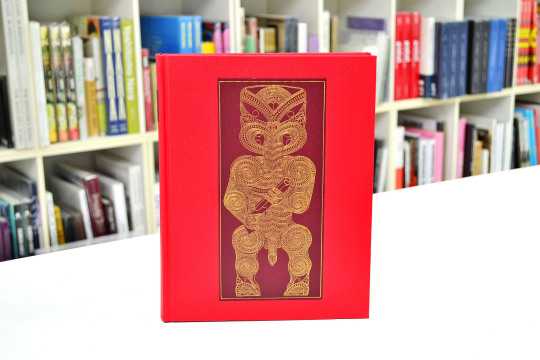
Jono Rotman
Mongrelism
ニュージーランド出身の写真家、ジョノ・ロットマンのストリートギャング「The Mongrel Mob of Aotearoa」をギャングのハンドブックのフォーマットによって記録した作品集。
ギャングのメンバーのほどんどが先住民のマオリ族出身で、作者はこのギャング発祥のエリアに最初に入植した白人4世。植民地化の過程と先住民のコミュニティの孤立化がこのストリートギャングを生んだ一因ともいえ、この作品集の中で、国家の歴史と共にいくつもの物語が錯綜している。
1年おきに開催されるヨーロッパ最大級の国際写真コンクール「Grand Prix Images Vevey」にて2017/2018年度「the Images Vevey Book Award」受賞
ISBN-10: 0993585388, ISBN-13: 978-0993585388
p.380, 26.3 x 2.3 x 21 cm
2018/10/10
Jono Rotman: Mongrelism
2 notes
·
View notes
Photo
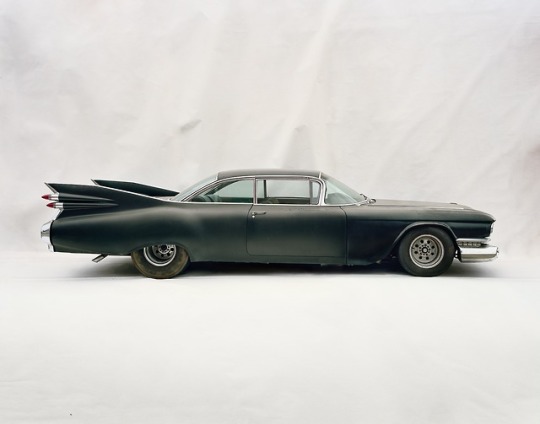
Maketu President's Cadillac 59 Coupe de Ville, Maketu, MMXVII
Jono Rotman Photography
#art#photography#mongrel mob#maketu#cadillac#coupe deville#jono rotman#new zealand#vintage cars#cool cars#luxury cars#luxury lifestyle#travels#59
73 notes
·
View notes
Photo
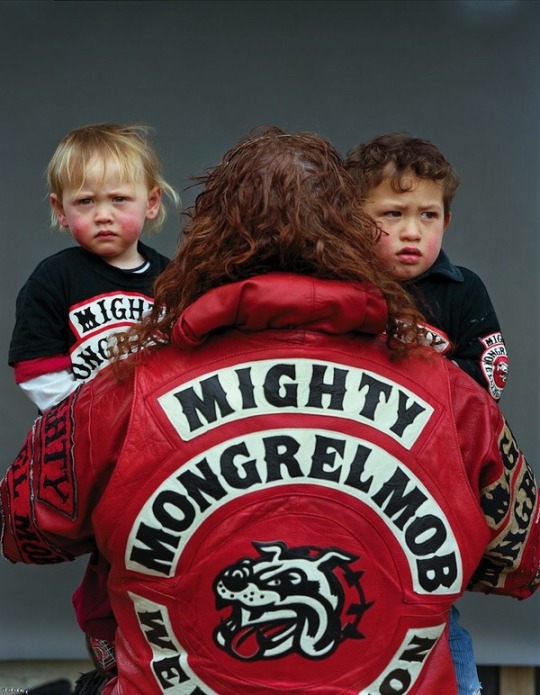
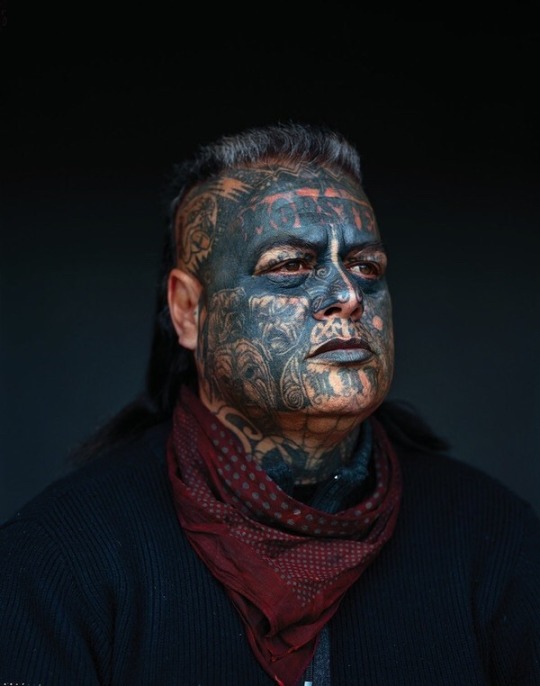


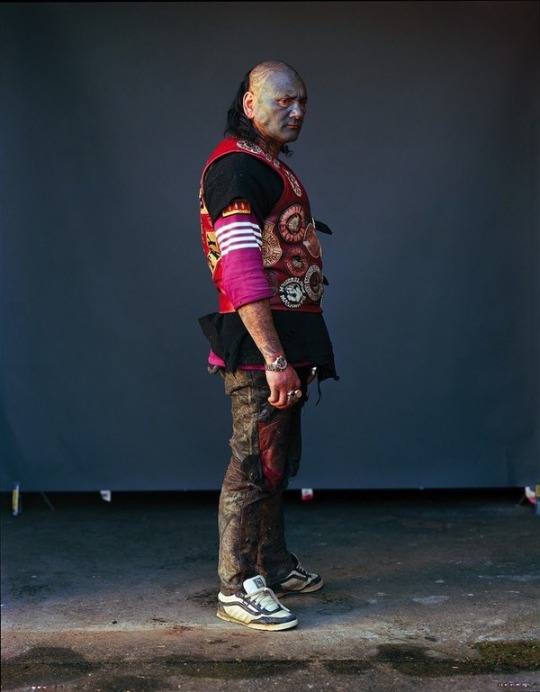
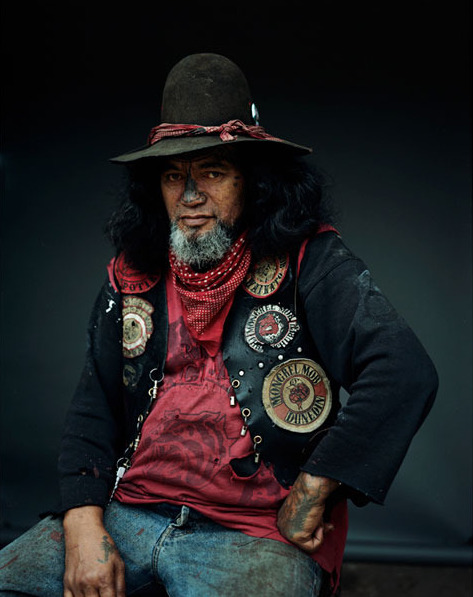

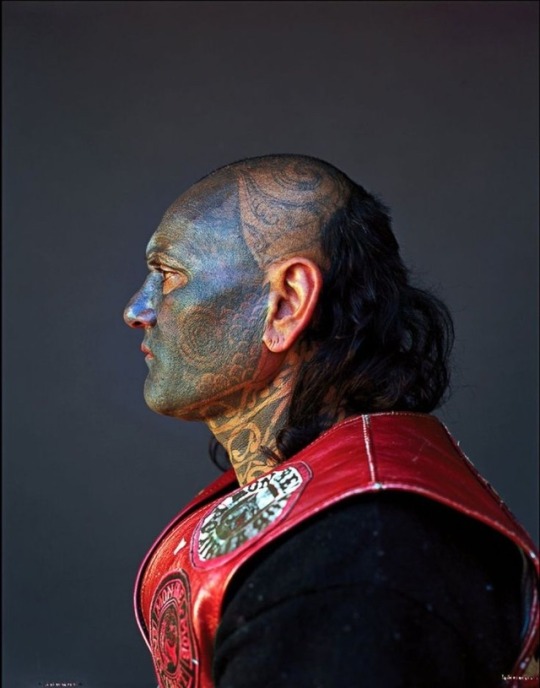
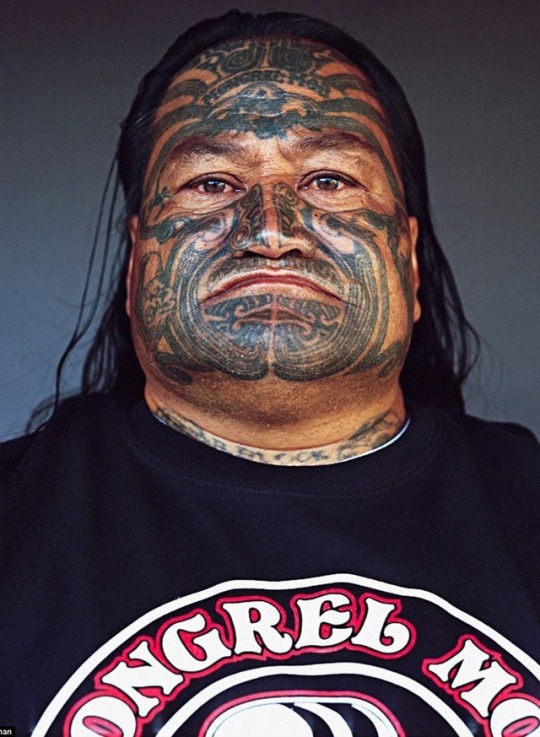
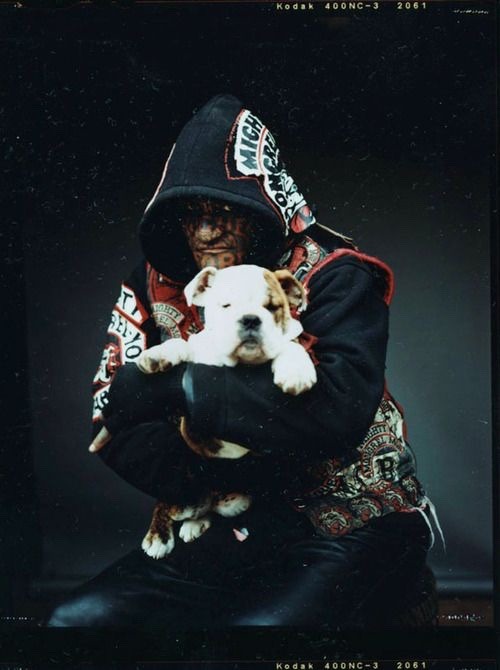
New Zealand photographer Jono Rotman got unprecedented access to around 200 members of the Mongrel Mob.
source
41 notes
·
View notes
Text
Critical and Contextual Awareness
Artists often explore the characteristics that determine our personal and social identity. They construct a sense of who we are as individuals, as a society, or as a nation. They question stereotypes and conventions while exploring attributes such as gender, sexuality, race, nationality and heritage.
Your personal identity is based around yourself which evolves over the course of your life. This includes elements of yourself that you have no control over such as age, skin colour, where you grew up. As well as choices you make in life such as things you believe in and how you spend your free time. You show people your personal identity by the way you interact with people and present yourself. However you can also keep aspects of your personal identity to yourself.
You identify yourself culturally by showcasing your interests and personality traits, as well as your beliefs and personal features such as age and race.
You may need to prove your identity if you’re going away on an airplane and may need to use your passport. You will also need to prove your legal identity when driving and will need your driving license. Finally you may need to use a proof of identification when purchasing alcohol and will need to present a proof of age card, such as the PASS card from the national Proof of Age Standards Scheme.
i-D Magazine/ Terry Jones
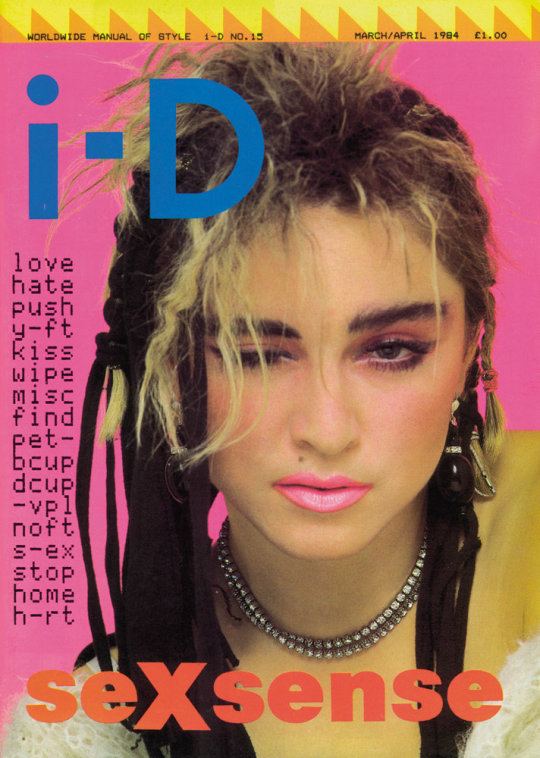
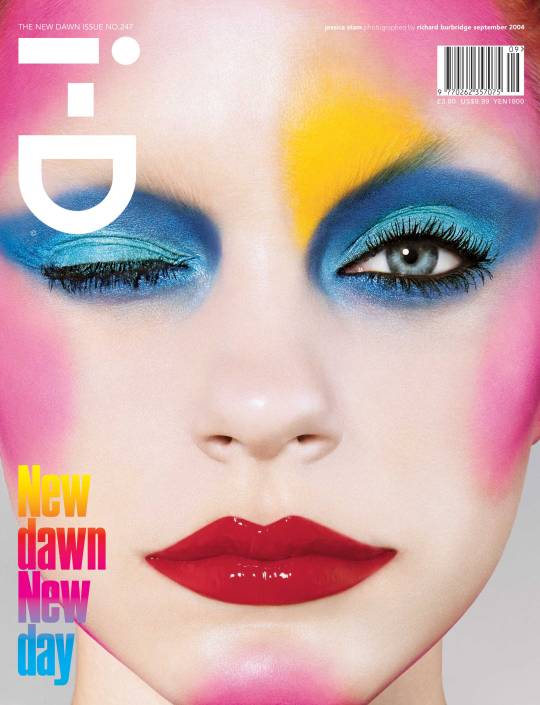
Terry Jones, when photographing for i-D magazine, uses the formal element colour. These colours can be used to connote emotions and feelings from the subject, to the viewer. Image comunicating is where the image is telling a story. These images communicate independence and confidence. This is suggested by the direct look of the models and their direct eye contact with the photographer helps the viewer communicate almost with the model in the photograph. In his photography he is uses colour to show happiness and a different aspect to the whole photograph. The materials the he used to do these photographs were colour, digital cameras.
The first image was taken in March/ April 1984
The second image was taken in September 2002
Gillian Wearing
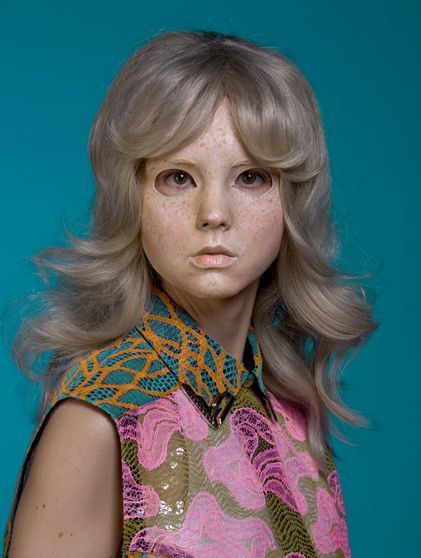

Gillian Wearing is an English conceptual artist, one of the Young British Artists, and winner of the annual British fine arts award, the Turner Prize, in 1997. In 2007 Wearing was elected as lifetime member of the Royal Academy of Arts in London.
Wearing portrays personal identity by communicating sadness within his photographs. I know this because he uses masks to cover the models faces which indicates that they're covering their personal identities. He uses digital cameras in order to create these images using lots of colour which contrasts from the sadness which is on the models faces. Wearing uses the formal element of colour in order to portray personal identity without actually having to show the models face.
Jono Rotman
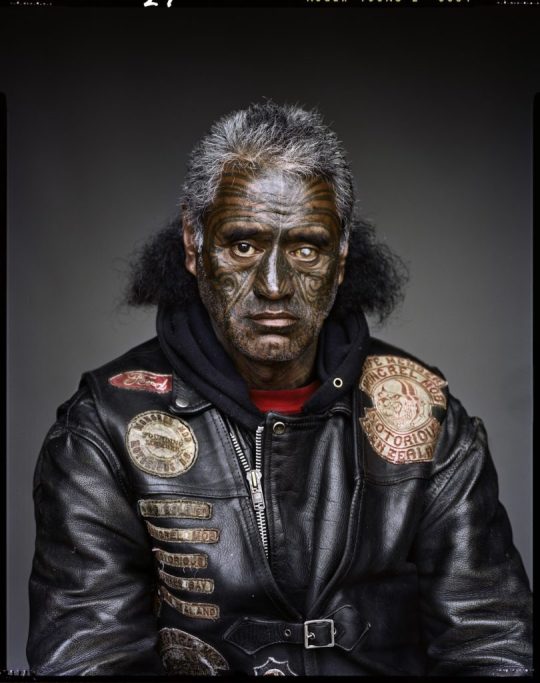

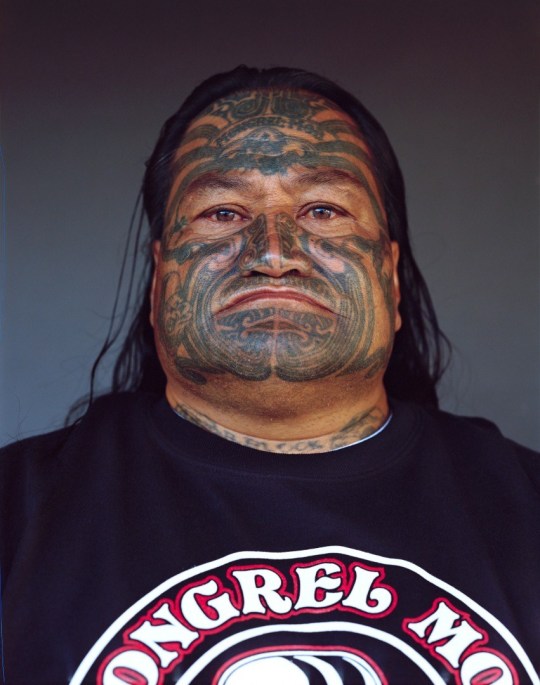
The plain backgrounds within Rotman’s photography makes us as the viewers put our main focus onto the models. He has focused on the formal element of lines and colour within this body of work. The blank expressions on the models faces don’t tell us as the viewers anything about their identities of lives. However we still communicate with them through their appearance, this includes their clothing, scars and tattoos. By looking at their clothing we can get the impression they enjoy some form of motorbiking due to the amounts of leather, therefore we’re finding out about their personal identity and hobbies through this series of images.
1 note
·
View note
Text
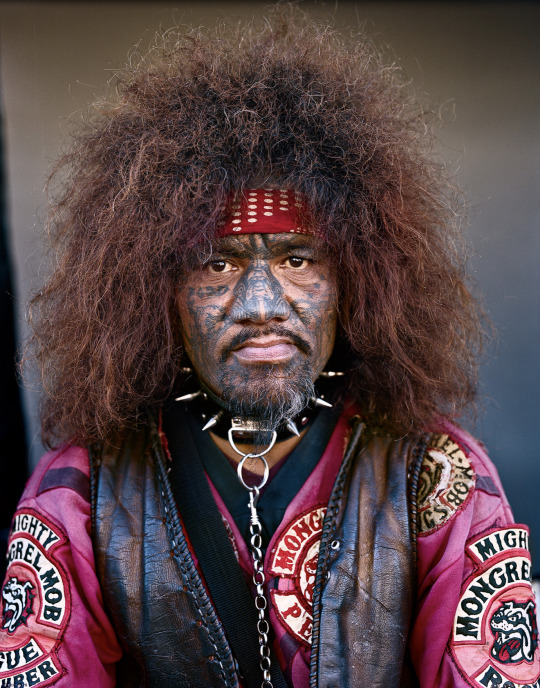
Jono Rotman, Mongrelism, portraits of The Mighty Mongrel Mob of Aotearoa, New Zealand
22 notes
·
View notes
Text
New Zealand’s Mongrel Mob gang, photographed by Jono Rotman
Jono Rotman’s Mongrelism project delves into the intimate lives of New Zealands largest gang the Mongrel Mob that confronts, challeges and at times has offended many viewers.

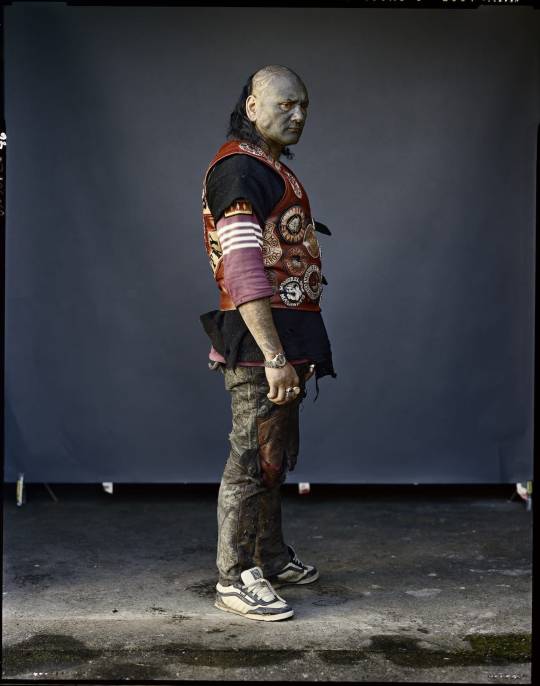
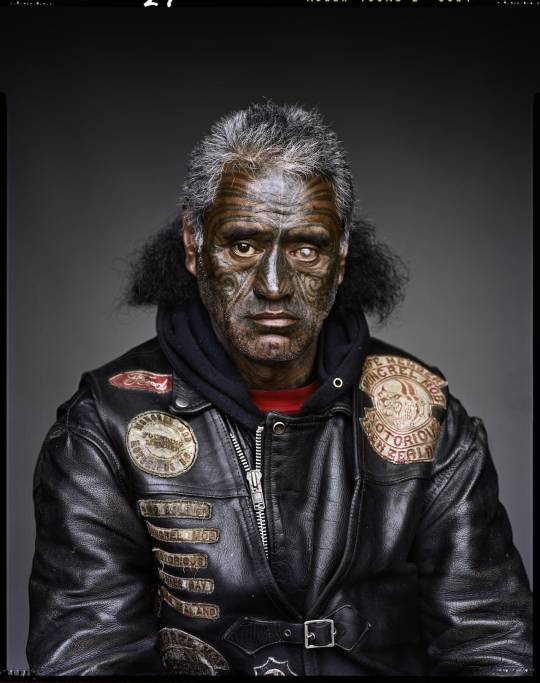
I have always been interested in portraits myself but found myself with mixed emotions over this series as personally I do not like what gang members stand for and felt that some of the images slightly glorified them through the lighting that was used. In saying this however, I feel that a photographer should never put their own bias into their work.
What intrigued me was the fact that Rotman chose subjects you wouldn’t typically photograph and shot them in a way people would not expect. You would expect there to be overcast with shadows such as the first of the above three images and very intense, but then there is the contrast of the brighter lighting of the third image above where the subject is spotlighted and very much in the public eye.
When I look at these images, it reminds me of the photographs of the old chiefs that adorn the walls of the museum. I always remember when I was younger and going through the museum, I used to stare at the photographs of the chiefs and wondered what they were thinking and what life was like for them. This rang true when I read the below statement from the article
Like the vacant spaces in Lockups, these photographs are void of context beyond the lone subject, leaving the viewer to grapple with the available information and details.
This is what happens when I look at Rotman’s images. It makes me wonder what life is like for the gang members so I applaud Rotman for this.
Building the right Kaupapa is extremely important to me when photographing portraits and I have found in the past it can sometimes take some time to establish this and sometimes I have had to change things to make it work such as the environment and the settings. Rotman in fact obviously went through this same process as he attempted to shoot his subjects in a studio setting which did not work so he then moved his equipment into their homes which changed the dynamic.
“Because I’m shooting large format with natural light, the process is really slow,” he explains. “So I have to give them a preamble: ‘You’re going to sit. Then I’m going to focus and mess around with the camera, and you can’t move.’ It creates a ceremonial process which, in effect, takes us both out of our roles.” The resulting portraits attest to a relationship of mutual understanding.
What I like most about this article and looking at the work of Rotamn is that it has challenged my views of portrait taking and makes me want to really consider more deeply my subject matter and how it can in turn challenge the viewer.
Haeusslein, Allie. “New Zealand’s Mongrel Mob gang, photographed by Jono Rotman”. 1845 Photography. Retrieved from https://www.1854.photography/2018/10/jono-rotman-mongrel/
Rotman, Jono. Mongrelism. 2018. https://www.1854.photography/2018/10/jono-rotman-mongrel/
0 notes
Link
0 notes
Photo
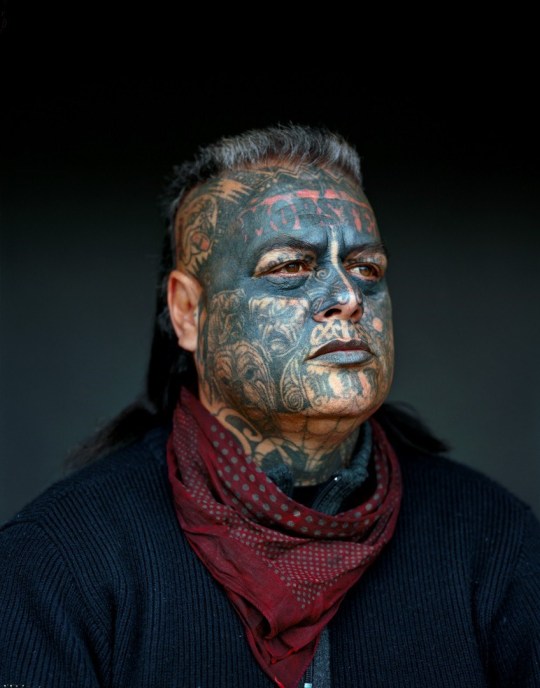
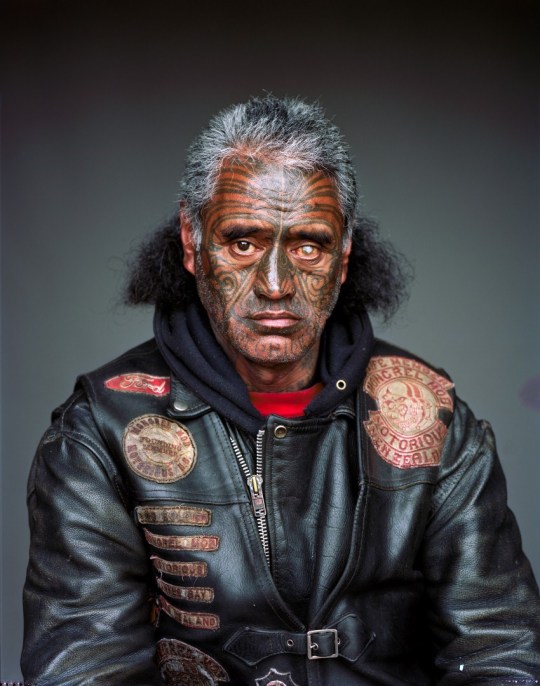
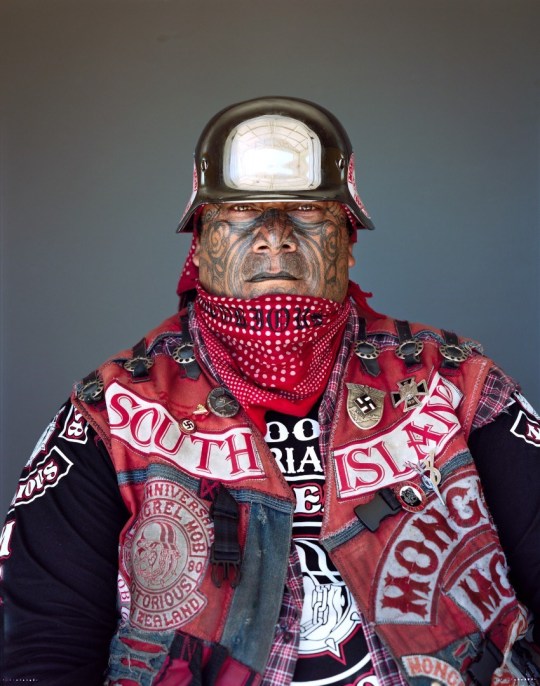
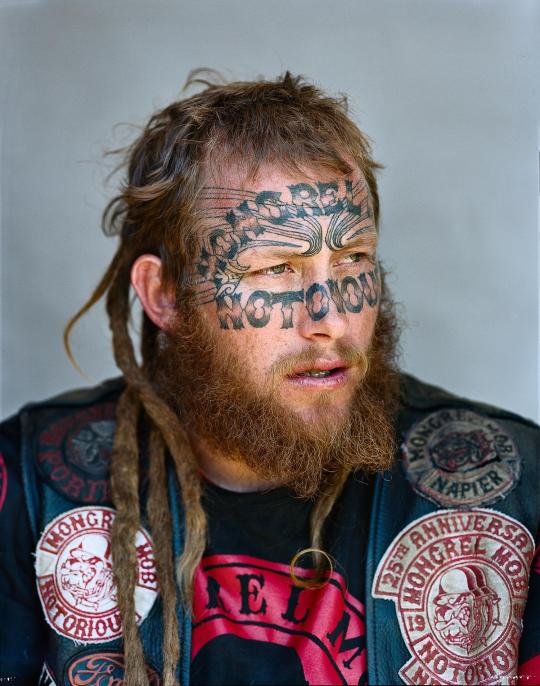
Rotman, Jono. Mongrelism. (2008-2009). NZ.
This series of portraits shows the Mob members pride in their identity and assertion of their membership. This is very interesting to me as I knew it would have to be completely transparent relationship between the subjects, gang and the photographer. A quote from the blurb on Rotmans website answered my ethics question “they have been involved in the editing process, exhibitions and are consulted about all use of the work.” This type of work shows that works are more successful if you take the time to understand and don’t go into shoots with preconceived ideas on how you want it to turn out. Immerse yourself and let it flow with complete respect for your subject and the results will be good.
0 notes
Photo
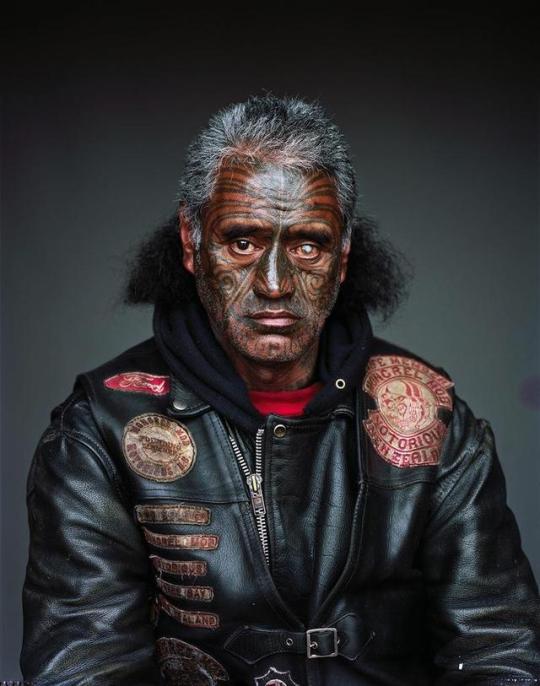
New Zealand photographer Jono Rotman's 2015 photo-essay on members of New Zealand gang "Mongrel Mob"
33 notes
·
View notes
